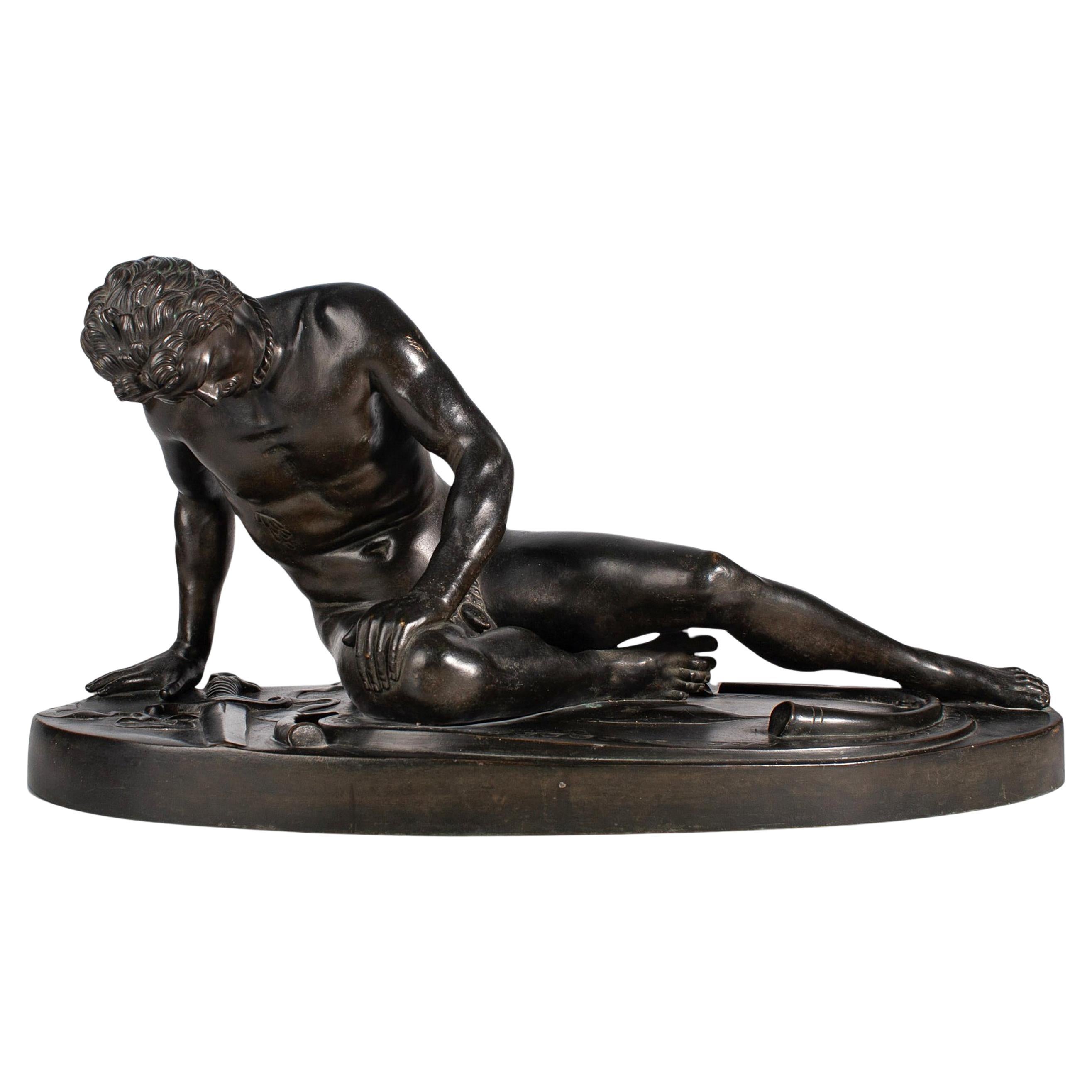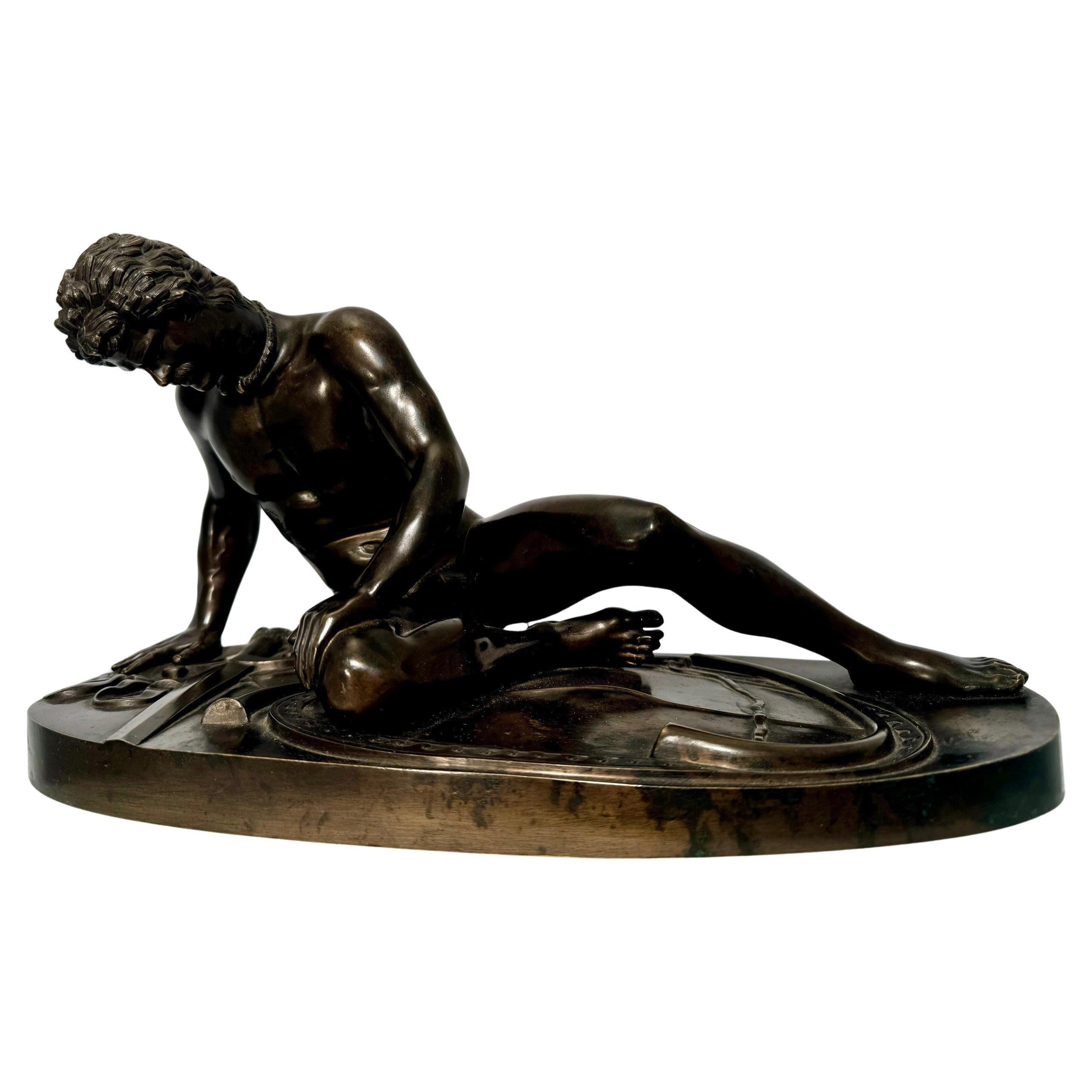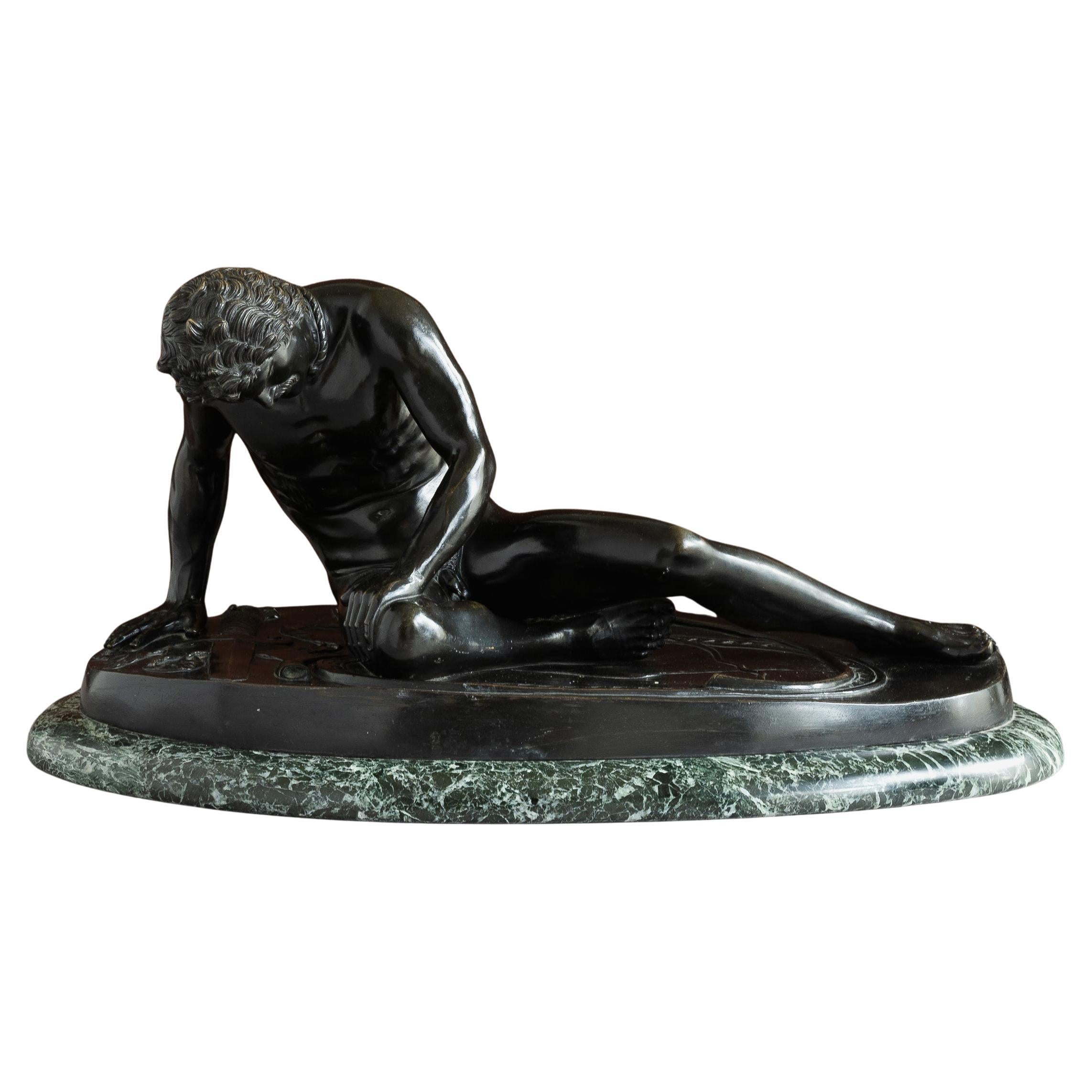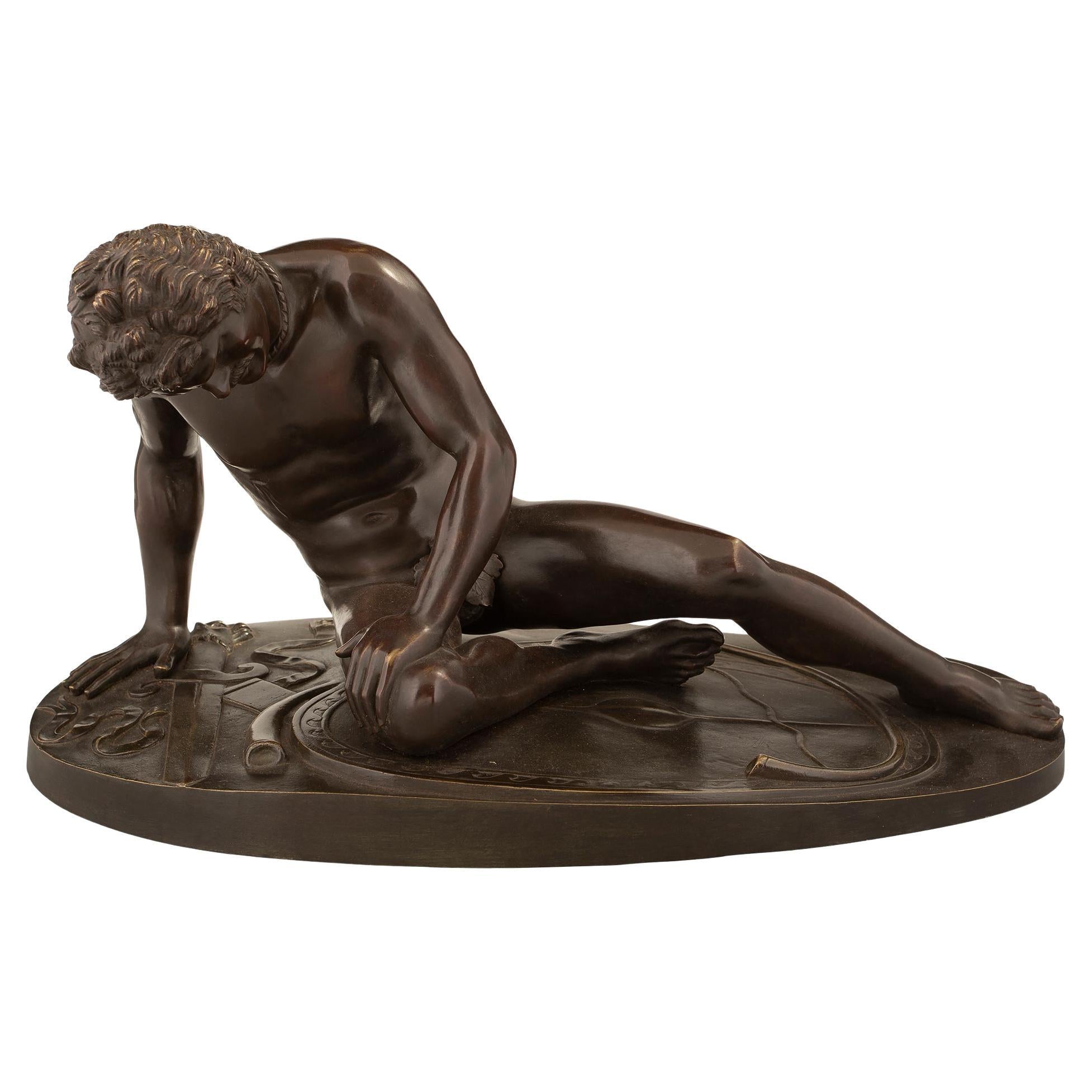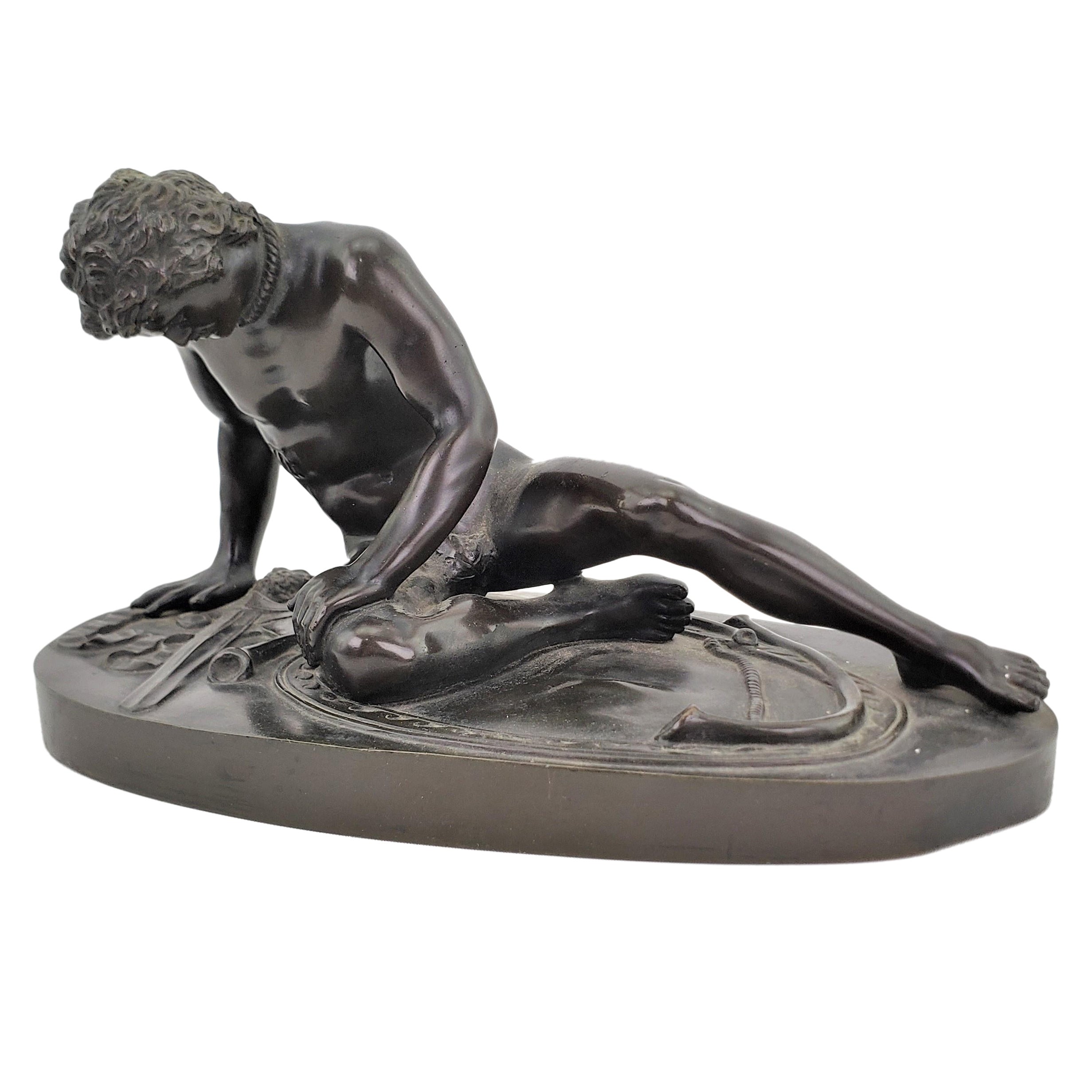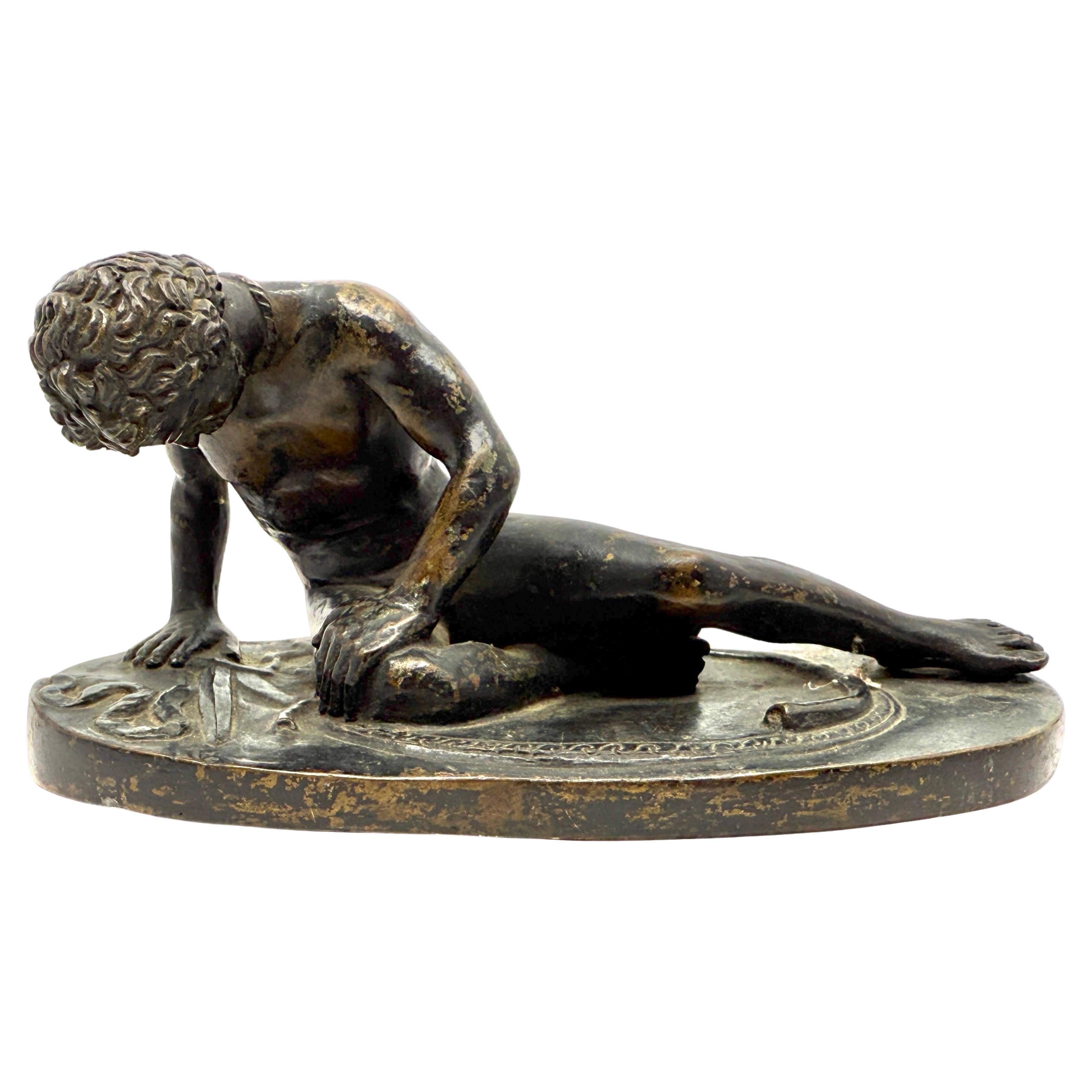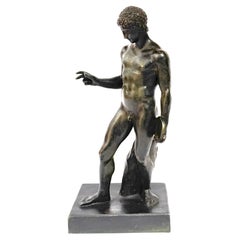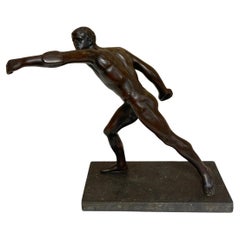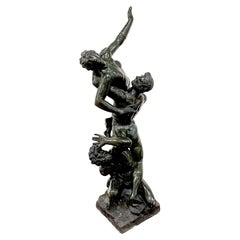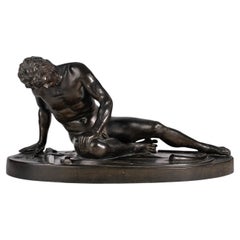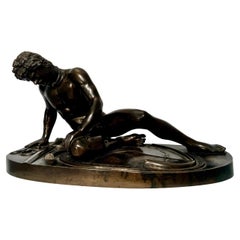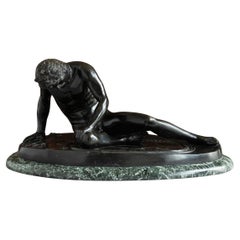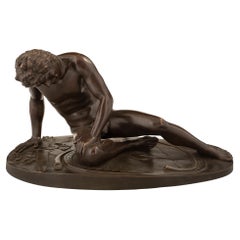Items Similar to Large Italian Grand Tour Bronze Sculpture "Dying Galata" /Dying Gaul, C. 1875
Want more images or videos?
Request additional images or videos from the seller
1 of 20
Large Italian Grand Tour Bronze Sculpture "Dying Galata" /Dying Gaul, C. 1875
$7,150
£5,431.01
€6,258.36
CA$10,068.97
A$11,162.94
CHF 5,866.56
MX$136,616.12
NOK 73,267.40
SEK 68,768.78
DKK 46,714.80
About the Item
Large Italian Grand Tour Bronze Sculpture "Dying Galata"/Dying Gaul, C. 1875, Attributed to Naples Foundry
A remarkable large Italian Grand Tour bronze sculpture titled "Dying Galata" or "Dying Gaul," dating circa 1875 and attributed to the renowned Naples Foundry. This exquisite piece, an expertly cast bronze, retains its original black-brown patina and boasts a substantial size, standing 12 inches high, 26.5 inches wide, and 13.5 inches deep. It is a distinguished example of the iconic Grand Tour sculptures, which were popular souvenirs for affluent travelers during the 19th century.
The sculpture is a faithful rendition of the ancient Roman marble statue "The Dying Gaul," also known as "The Dying Galatian" or "The Dying Gladiator." The original marble, now housed in the Capitoline Museums in Rome, is a Roman copy of a lost Greek bronze sculpture from the Hellenistic period (323–31 BC). The original work is believed to have been commissioned by Attalus I of Pergamon between 230 and 220 BC to commemorate his victory over the Galatians, a Celtic people from Anatolia. The sculptor is thought to be Epigonus, a renowned artist of the time.
Historically, the marble statue was referred to as "The Dying Gladiator," under the assumption that it depicted a wounded gladiator in a Roman amphitheater. However, by the mid-19th century, it was re-identified as a Galatian, and the name "Dying Gaul" gained widespread acceptance. The figure’s identification as a "barbarian" is supported by his torc, thick hair, mustache, and the Gallic carnyx depicted between his legs, along with weapons and a shield carved on the ground. This sculpture is a testament to the rich history and artistry of the Hellenistic and Roman eras, making it a prized addition to any collection and/or interior.
Overall Measurements:
12-inches high, 26.5 inches wide, and 13.5 inches deep
Figure alone is 10-inches high, 25 inches wide, and 9 inches deep.
- Dimensions:Height: 12 in (30.48 cm)Width: 26.5 in (67.31 cm)Depth: 13.5 in (34.29 cm)
- Style:Grand Tour (Of the Period)
- Materials and Techniques:
- Place of Origin:
- Period:
- Date of Manufacture:1875
- Condition:Wear consistent with age and use.
- Seller Location:West Palm Beach, FL
- Reference Number:Seller: SDHU5T25341stDibs: LU2592341387842
About the Seller
5.0
Platinum Seller
Premium sellers with a 4.7+ rating and 24-hour response times
Established in 1996
1stDibs seller since 2017
1,419 sales on 1stDibs
Typical response time: <1 hour
- ShippingRetrieving quote...Shipping from: Round Top, TX
- Return Policy
Authenticity Guarantee
In the unlikely event there’s an issue with an item’s authenticity, contact us within 1 year for a full refund. DetailsMoney-Back Guarantee
If your item is not as described, is damaged in transit, or does not arrive, contact us within 7 days for a full refund. Details24-Hour Cancellation
You have a 24-hour grace period in which to reconsider your purchase, with no questions asked.Vetted Professional Sellers
Our world-class sellers must adhere to strict standards for service and quality, maintaining the integrity of our listings.Price-Match Guarantee
If you find that a seller listed the same item for a lower price elsewhere, we’ll match it.Trusted Global Delivery
Our best-in-class carrier network provides specialized shipping options worldwide, including custom delivery.More From This Seller
View All19th C. Italian Bronze Grand Tour Sculpture Nude Discuss Athlete, in Repose
Located in West Palm Beach, FL
19th C. Italian Bronze Grand Tour Sculpture Nude Discuss Athlete, in Repose
Attributed to the Naples Foundry, mid-19th century or older casting
A 19th-century Italian Grand Tour ...
Category
Antique Mid-19th Century Italian Grand Tour Figurative Sculptures
Materials
Bronze
19th C. Italian Grand Tour Bronze of the Gladiator, After the Roman Antique
Located in West Palm Beach, FL
19th-century Italian Grand Tour Bronze of the Gladiator, After the Roman Antique
Attributed to the Naples Foundry, late 19th century
This fine 19th-century Italian Grand Tour bronze...
Category
Antique 19th Century Italian Grand Tour Figurative Sculptures
Materials
Marble, Bronze
$1,480 Sale Price
20% Off
19th Century French Ormolu & Patinated Bronze Sculpture of a Seated Satyr
Located in West Palm Beach, FL
19th Century French Ormolu & Patinated Bronze Sculpture of a Seated Satyr
France, Circa 1875
A good quality 19th Century French Ormolu & Patinated Bronze Sculpture of a Seated Saty...
Category
Antique 19th Century Figurative Sculptures
Materials
Bronze, Ormolu
$760 Sale Price
20% Off
Grand Tour Verdigris Marble After Giambologna, The Abduction of a Sabine Woman'
By Giambologna, Benedetto Boschetti
Located in West Palm Beach, FL
Grand Tour Verdigris Marble After Giambologna, The Abduction of a Sabine Woman'
Italy, Mid- 19th century, Attributed to the workshops of Benedetto Bosch...
Category
Antique Mid-19th Century Italian Renaissance Figurative Sculptures
Materials
Marble
Austrian Erotic Bronze Nymph & Satyr, Style of Bergman
By Franz Bergmann
Located in West Palm Beach, FL
Austrian Erotic Bronze Nymph & Satyr, Style of Bergman
Austria, circa 1900s
A well executed two piece bronze, that presents the naked female figure f...
Category
20th Century Austrian Belle Époque Figurative Sculptures
Materials
Bronze
$1,196 Sale Price
20% Off
Exquisite Bronze & Marble Reclining Venus Holding Pomegranate, After Canova
By Antonio Canova
Located in West Palm Beach, FL
Exquisite Bronze & Marble Reclining Venus Holding Pomegranate, After Canova, 20th Century
A finely cast and chased bronze of a reclining classical beauty, inspired by Antonio Canova...
Category
20th Century European Neoclassical Figurative Sculptures
Materials
Carrara Marble, Bronze
You May Also Like
Mid-19th Century Grand Tour Bronze Figurative Sculpture 'The Dying Gaul', Italy
Located in North Miami, FL
Mid-19th Century Grand Tour Bronze Figurative Sculpture 'The Dying Gaul', Italy
By: unknown
Material: bronze, copper, metal
Technique: cast, molded, polished, metalwork, patinated
D...
Category
Antique 1850s Italian Grand Tour Figurative Sculptures
Materials
Metal, Bronze, Copper
Grand Tour bronze figure of “The Dying Gaul”, After The Antique
Located in Montreal, QC
A late 19th century Grand Tour bronze figure of “The Dying Gaul”, after the antique. The Dying Gaul depicts a warrior in his final moments, next to his shield and sword, his face contorted in pain just before he collapses from the mortal wound to his chest The original marble figure, which is in the Capitoline museum in Rome is thought to be a Roman copy of a Greek sculpture in Bronze. As an image of a vanquished enemy, the sculpture embodies courage in defeat, self-possession in the face of death, and the recognition of nobility in an alien race.
“The Dying Gaul” was found in Rome with another ancient marble...
Category
Antique Late 19th Century Italian Classical Greek Figurative Sculptures
Materials
Bronze
Antique Bronze Figure of The Dying Gaul
Located in London, GB
A bronze figure of the dying Gaul after the Antique, on verde marble base, Italian, nineteenth century.
Dimensions: 30.5cm (12") High, 35cm (13¾") Wide, 65cm (25½") Long, 13.5cm (5¼...
Category
Antique 19th Century Italian Classical Greek Figurative Sculptures
Materials
Marble, Bronze
Italian 19th Century Patinated Statue of ‘The Dying Gaul’
Located in West Palm Beach, FL
A handsome Italian 19th century patinated statue of 'The Dying Gaul'. The statue is raised by an oval shaped terrain like designed base. The fallen gladiato...
Category
Antique 19th Century Italian Figurative Sculptures
Materials
Bronze
Antique Grand Tour Ornately Cast 'The Dying Gaul' Italian Bronze Sculpture
Located in Hamilton, Ontario
This very ornately cast bronze sculpture is unsigned, but presumed to have been done in Italy in approximately 1900, in the Classical Roman style. This figurative study depicts the famous Classical Roman sculpture known as 'The Dying Gaul...
Category
Early 20th Century Italian Classical Roman Figurative Sculptures
Materials
Bronze
Grand Tour Neoclassical Bronze of “The Dying Gaul”
Located in Palm Springs, CA
A nice little bronze Grand Tour souvenir bronze of the Dying Gaul a famous sculpture of antiquity preserved in Rome. This bronze has nice detail. The patina is worn in some places and it is in estate found condition. We haven’t tried to clean or polish it.
Some patina loss minor nicks and surfaces scratches, please see the detailed photos.
For this interested this from Wikipedia about the original sculpture:
The Dying Gaul, also called The Dying Galatian[2] (Italian: Galata Morente) or The Dying Gladiator, is an ancient Roman marble semi-recumbent statue now in the Capitoline Museums in Rome. It is a copy of a now lost Greek sculpture from the Hellenistic period (323–31 BC) thought to have been made in bronze.[3] The original may have been commissioned at some time between 230 and 220 BC by Attalus I of Pergamon to celebrate his victory over the Galatians, the Celtic or Gaulish people of parts of Anatolia. The original sculptor is believed to have been Epigonus, a court sculptor of the Attalid dynasty of Pergamon.
Until the 20th century, the marble statue was usually known as The Dying Gladiator, on the assumption that it depicted a wounded gladiator in a Roman amphitheatre.[4] However, in the mid-19th century it was re-identified as a Gaul or Galatian and the present name "Dying Gaul" gradually achieved popular acceptance. The identification as a "barbarian" was evidenced for the figure's neck torc, thick hair and moustache, weapons and shield carved on the floor, and a type of Gallic carnyx between his legs.[5]
Description
The white marble statue, which may originally have been painted, depicts a wounded, slumped Gaulish or Galatian Celt, shown with remarkable realism and pathos, particularly as regards the face. A bleeding sword puncture is visible in his lower right chest. The warrior is represented with characteristic Celtic hairstyle and moustache with a Celtic torc...
Category
Early 20th Century Italian Figurative Sculptures
Materials
Bronze
